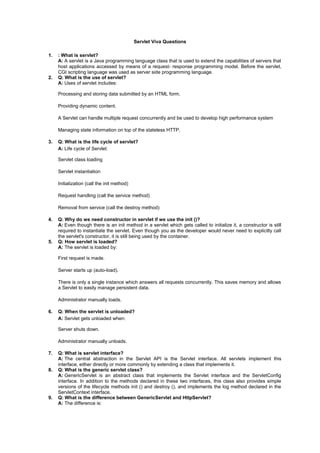
Servlet Interview Questions
- 1. Servlet Viva Questions 1. : What is servlet? A: A servlet is a Java programming language class that is used to extend the capabilities of servers that host applications accessed by means of a request- response programming model. Before the servlet, CGI scripting language was used as server side programming language. 2. Q: What is the use of servlet? A: Uses of servlet includes: Processing and storing data submitted by an HTML form. Providing dynamic content. A Servlet can handle multiple request concurrently and be used to develop high performance system Managing state information on top of the stateless HTTP. 3. Q: What is the life cycle of servlet? A: Life cycle of Servlet: Servlet class loading Servlet instantiation Initialization (call the init method) Request handling (call the service method) Removal from service (call the destroy method) 4. Q: Why do we need constructor in servlet if we use the init ()? A: Even though there is an init method in a servlet which gets called to initialize it, a constructor is still required to instantiate the servlet. Even though you as the developer would never need to explicitly call the servlet's constructor, it is still being used by the container. 5. Q: How servlet is loaded? A: The servlet is loaded by: First request is made. Server starts up (auto-load). There is only a single instance which answers all requests concurrently. This saves memory and allows a Servlet to easily manage persistent data. Administrator manually loads. 6. Q: When the servlet is unloaded? A: Servlet gets unloaded when: Server shuts down. Administrator manually unloads. 7. Q: What is servlet interface? A: The central abstraction in the Servlet API is the Servlet interface. All servlets implement this interface, either directly or more commonly by extending a class that implements it. 8. Q: What is the generic servlet class? A: GenericServlet is an abstract class that implements the Servlet interface and the ServletConfig interface. In addition to the methods declared in these two interfaces, this class also provides simple versions of the lifecycle methods init () and destroy (), and implements the log method declared in the ServletContext interface. 9. Q: What is the difference between GenericServlet and HttpServlet? A: The difference is:
- 2. The GenericServlet is an abstract class that is extended by HttpServlet to provide HTTP protocol-specific methods. But HttpServlet extends the GenericServlet base class and provides a framework for handling the HTTP protocol. The GenericServlet does not include protocol-specific methods for handling request parameters, cookies, sessions and setting response headers. The HttpServlet subclass passes generic service method requests to the relevant doGet () or doPost () method. GenericServlet is not specific to any protocol. HttpServlet only supports HTTP and HTTPS protocol. 10. Q: Why HttpServlet class is declared abstract? A: The HttpServlet class is declared abstract because the default implementations of the main service methods do nothing and must be overridden. This is a convenience implementation of the Servlet interface, which means that developers do not need to implement all service methods. If your servlet is required to handle doGet () requests for example, there is no need to write a doPost () method too. 11. Q: Can servlet have a constructor? A: Yes 12. Q: What are the type of protocols supported by the HttpServlet? A: It extends the GenericServlet base class and provides a framework for handling the HTTP protocol. So, HttpServlet only supports HTTP and HTTPS protocol. 13. Q: What is the difference between the doGet () and doPost ()? A: The difference is: In doGet() the parameters are appended to the URL and sent along with header information. In doPost (),send the information through a socket back to the webserver and it won't show up in the URL bar. The amount of information you can send back using a GET is restricted as URLs can only be 1024 characters. You can send much more information to the server by using post and it's not restricted to textual data either. It is possible to send files and even binary data such as serialized Java objects! DoGet() is a request for information.It does not change anything on the server. (doGet () should be idempotent). doPost () provides information (such as placing an order for merchandise) that the server is expected to remember. 14. Q: When to use doGet() and when doPost()? A:Always prefer to use GET (As because GET is faster than POST), except mentioned in the following reason: If data is sensitive. Data is greater than 1024 characters. If your application don't need bookmarks. 15. Q: How do I support both doGet () and doPost () from same servlet? A:The easy way is, just support POST, then have your doGet method call your doPost method.
